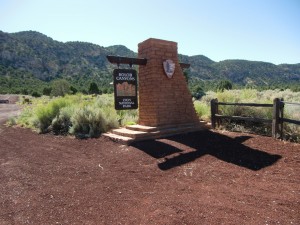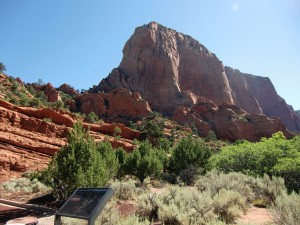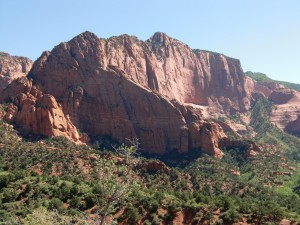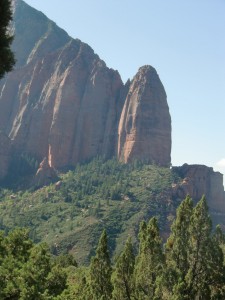DISCOVERING KOLOB CANYON
DISCOVERING KOLOB CANYON
By Charles N. Stevens
Photos by Dolores Seidman
Our main objective in visiting the Cedar City, Utah area is to spend a few days at the Utah Shakespeare Festival, but more about that later. Just below Cedar City, about fifteen miles on Interstate 15, is the entrance to Kolob Canyon. Since the canyon is actually part of Zion National Park, we need to register at the ranger station before driving the five mile road into the canyon.
We are soon taken by the natural beauty of the canyon with its lush vegetation, towering red sandstone cliffs and layers of rock tilted by geological forces. It is so picturesque that we stop numerous times to photograph breathtaking scenes. I was impressed with the health of the pines and cedars, the brush-like manzanita and even the weeds, all growing to their full potential, thriving. Every leaf was shiny with vigor. The canyon afforded a perfect environment for all the many species it contained. Shrubs and even tall trees flourish on isolated ledges clinging to the cliffs or, it seems, out of solid rock. Far across the canyon the sun glistens on water seeping out of springs in the bare rock.
Hiking trails are abundant in the canyon. The large number of cars parked at the trailheads is a good indication of their popularity. Due to our advanced ages, we did not attempt the trails, but we stepped into them far enough to get the feel of them, the shadows of the trees, the green foliage all around us.
The Anasazi (“The Ancient Ones”) first lived in the canyon, but departed the area around 1200 AD. Later, the Paiute Indians moved in. I can’t help but think about the Indians who lived there; they must have felt they had discovered paradise. Mormon pioneers found the area in the 1850s, using the canyon to cut timber, graze cattle and explore for minerals. They named the canyon Kolob, after the star that is closest to the planet where they believe God resides.
Geologically speaking, the road up the canyon follows the Hurricane Fault, 150 mile “crack” that begins near the Grand Canyon, causing the twisted strata or rocks and the unusual formations. The attractive reddish monoliths and cliffs are composed of Navajo Sandstone that originated over 150 million years ago when the landscape was one of arid deserts and sand dunes. The earth is constantly changing, but slowly over millions of years, a concept difficult to comprehend considering man’s very short life span. Geologists use the rocks to determine what a place was like so many years ago.
But regardless of the faults and rocks and why they exist, we marvel at the present beauty of the canyon, the spectacular scenery around every bend in the road.
We park at the end of the road and take a short walk among the pinyon pines, shortly coming upon a picnic area with a scattering of tables. I sit in the shade of a pinyon while Dolores explores more of the trail. So, for a bit, I have the place all to myself.
I sit at a metal table in the natural shelter of Pinyon pines and junipers, listening to the wind singing through them. Some of the stronger gusts sound shrill, but when the wind ceases a deep silence falls over the sanctuary of trees. The quietness is so complete that I can hear a fly buzz. Outside the shade, the noon sun sears the pinkish gravel and dust with clumps of gray-green sage. The hot sun allows the trees to release their resinous scent, one I associate with being outdoors in a wild place. Sharp shadows on the ground tremble with the wind.
Like a bolt of blue, a scrub jay sweeps out of an adjoining tree then lands close to me. It cocks its head at me then flutters up to the table, hopping about with the scratchy sound of its feet on the metal surface. A red ant stings my arm.
Beyond my bower stand the dark red cliffs, stained here and there with streaks made by spring waterfalls, now dry. The forests are dense, each tree and shrub brimming with health. There is a vital glow about the trees, as though they have found plant happiness. Life is just right for them.
If you want to see a place of pure natural beauty, Kolob Canyon is the place to be.

The entrance to Kolob Canyon, just off I-15, is well marked.

Monoliths of reddish iron-stained rock dominate the canyon.

Forests thrive in the rocky soil all growing to their fullest in this beautiful canyon.

This towering monolith resembles a giant cathedral.
MONTEREY PARK AUTHOR PUBLISHES 4th BOOK – Seeking More of the Sky: Growing Up in the 1930’s:
Charles “Norm” Stevens, a 43 year resident of Monterey Park has recently published his 4th book: Seeking More of the Sky: Growing Up in the 1930’s. This is the story of a young boy growing up in Inglewood, California in the l930’s. This was a time during the depression when unemployment was affecting many and the banks were closed, while the clouds of war were gathering in Europe. But he was lucky enough to be raised in a loving family, the power of that love reflected throughout his stories.
Stevens is the author of three previous books about his experiences during WWII:
An Innocent at Polebrook: A Memoir of an 8th Air Force Bombardier (Story of his 34 bombing missions from his base at Polebrook, England over Germany and France)
The Innocent Cadet: Becoming A World War II Bombardier (A prequel to the first, telling of his training in the U.S. before going overseas into combat.)
Back from Combat: A WWII Bombardier Faces His Military Future from Combat: (This book details the time from when he returned from combat in England until the end of the war.)
He is known to the readers of The Citizen’s Voice as the author of Travel Log Articles including “Cruising the Rhine and Mosel”,” Best of the West”, “In Search of Snow” , “From Paris to Normandy on the Seine”, and “Exploring New York”. He is retired, having taught for 32 years, primarily in the Montebello Unified School District.
Those interested in purchasing an autographed copy of any of his books, may contact the author at 323-721-8230 or Normstevens24@gmail.com.



